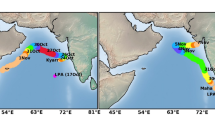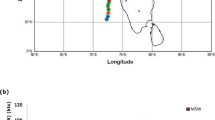Abstract
Cyclonic storms having maximum winds of 34 knots and above that had genesis in north Indian Ocean have been studied with respect to the eastward passage of Madden–Julian Oscillation (MJO). In the three decades (1979–2008), there were a total of 118 cyclones reported in which 96 formed in the region chosen (0–15oN, 60oE–100oE) for the study. Although the percentage of MJO days inducing cyclogenesis is small, it is found that tropical cyclone genesis preferentially occurred during the convective phase of MJO. This accounted for 44 cyclones of the total 54 cyclones (i.e., 81.5%) formed under MJO amplitude 1 and above. The study has shown that, when the enhanced convection of MJO is over the maritime continent and the adjoining eastern Indian Ocean, it creates the highest favorable environment for cyclogenesis in the Bay of Bengal. During this phase, westerlies at 850 hPa are strong in the equatorial region south of Bay of Bengal creating strong cyclonic vorticity in the lower troposphere along with the low vertical wind shear.









Similar content being viewed by others
References
Atlas IMD (1979) Tracks of storms and depressions in the Bay of Bengal and the Arabian Sea. India Meteorological Department, New Delhi, India
Belanger JI, Curry JA, Webster PJ (2010) Predictability of north Atlantic tropical cyclone activity on intraseasonal time scales. Mon Weather Rev 138:4362–4374
Bessafi M, Wheeler MC (2006) Modulation of south Indian Ocean tropical cyclones by the Madden–Julian oscillation and convectively coupled equatorial waves. Mon Weather Rev 134:638–656
Chand SS, Walsh KJE (2009) Tropical cyclone activity in the Fiji region: spatial patterns and relationship to large-scale circulation. J Clim 22(14):3877–3893
Gray WM (1968) Global view of the origin of tropical disturbances and storms. Mon Weather Rev 96:669–700
Gray WM (1979) Hurricanes: their formation, structure, and likely role in the tropical circulation. In: Shaw DB (ed) Meteorology over the tropical oceans. Royal Meteorological Society, London, pp 155–218
Hall JD, Matthews AJ, Karoly J (2001) The modulation of tropical cyclone activity in the Australian region by the Madden–Julian oscillation. Mon Weather Rev 129:2970–2982
Hartmann DL, Maloney ED (2001) The Madden–Julian Oscillation, barotropic dynamics, and north Pacific tropical cyclone formation. Part II: stochastic barotropic modeling. J Atmos Sci 58:2559–2570
Kalnay E, Coauthors (1996) The NCEP/NCAR 40-year reanalysis project. Bull Am Meterol Soc 77:437–471
Kikuchi K, Wang B (2010) Formation of tropical cyclones in the northern Indian Ocean associated with two types of tropical intraseasonal oscillation modes. J Meteorol Soc Jpn 88(3):475–496
Kim JH, Ho CH, Kim HS, Cui CH, Park SK (2008) Systematic variation of summertime tropical cyclone activity in the western North Pacific in relation to the Madden–Julian oscillation. J Clim 15:1171–1191
Klotzbach PJ (2010) On the Madden-Julian Oscillation–Atlantic hurricane relationship. J Clim 23:282–293
Knapp KR, Kruk MC (2010) Quantifying interagency differences in tropical cyclone best-track wind speed estimates. Mon Weather Rev 138(4):1459–1473
Knapp KR, Michael CK, David HL, Howard JD, Neumann CJ (2010) The International Best Track Archive for Climate Stewardship (IBTrACS): unifying tropical cyclone data. Bull Am Meteorol Soc 91:363–376
Leroy A, Wheeler MC (2008) Statistical prediction of weekly tropical cyclone activity in the Southern Hemisphere. Mon Weather Rev 136:3637–3654
Liebmann B, Smith CA (1996) Description of a complete (interpolated) OLR dataset. Bull Am Meteorol Soc 77:1275–1277
Liebmann B, Hendon HH, Glick JD (1994) The relationship between tropical cyclones of the western Pacific and Indian Oceans and the Madden–Julian oscillation. J Meteorol Soc Jpn 72:401–412
Madden RA, Julian PR (1971) Detection of a 40–50 day oscillation in the zonal wind in the tropical Pacific. J Atmos Sci 28:702–708
Maloney ED, Hartmann DL (2000a) Modulation of eastern North Pacific hurricanes by the Madden–Julian Oscillation. J Clim 13:1451–1460
Maloney ED, Hartmann DL (2000b) Modulation of hurricane activity in the Gulf of Mexico by the Madden–Julian Oscillation. Science 287:2002–2004
Maloney ED, Hartmann DL (2001) The Madden–Julian Oscillation, barotropic dynamics, and North Pacific tropical cyclone formation. Part I: observations. J Atmos Sci 58:2545–2558
McBride JL (1995) Tropical cyclone formation. Global perspective on tropical cyclones, WMO Tech Doc. 693, World Meteorological Organization, 63–105.
Nakazawa T (1986) Intraseasonal variations of OLR in the tropics during the FGGE year. J Meteorol Soc Jpn 64:17–34
Nakazawa T (1988) Tropical super clusters within intraseasonal variations over the western Pacific. J Meteorol Soc Jpn 66:823–839
Roundy PE (2008) Analysis of convectively coupled Kelvin waves in the Indian Ocean MJO. J Atmos Sci 65:1342–1359
Rui H, Wang B (1990) Development characteristics and dynamic structure of tropical intraseasonal convection anomalies. J Atmos Sci 47:357–379
Wheeler MC, Hendon HH (2004) An all-season real-time multivariate MJO index: development of an index for monitoring and prediction. Mon Wea Rev 132:1917–1932
Acknowledgments
The authors would like to acknowledge the facilities provided by Cochin University of Science and Technology, India, to carry out this research. The first author (KKS) is thankful to Council for Scientific and Industrial Research, India, for providing the fellowship supporting the research.
Author information
Authors and Affiliations
Corresponding author
Rights and permissions
About this article
Cite this article
Krishnamohan, K.S., Mohanakumar, K. & Joseph, P.V. The influence of Madden–Julian Oscillation in the genesis of North Indian Ocean tropical cyclones. Theor Appl Climatol 109, 271–282 (2012). https://doi.org/10.1007/s00704-011-0582-x
Received:
Accepted:
Published:
Issue Date:
DOI: https://doi.org/10.1007/s00704-011-0582-x




